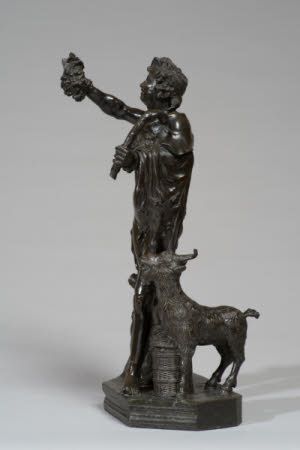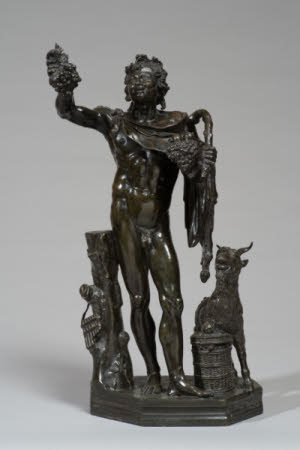The Faun in Rosso Antico
Giovanni Zoffoli (c.1745-1805) and Giacomo Zoffoli (c.1731-1785)
Category
Art / Sculpture
Date
c. 1760 - 1780
Materials
Bronze
Measurements
361 x 170 x 109 mm
Place of origin
Rome
Order this imageCollection
Anglesey Abbey, Cambridgeshire
NT 515054
Summary
Bronze, The Faun in Rosso Antico, Giacomo (c. 1731-85) or Giovanni Zoffoli (c. 1745-1805), c. 1760-1780. A bronze reduction of the famous antique statue of a faun with a goat, in rosso antico marble, excavated at Hadrian's Villa in 1736, and acquired in 1746 for the Capitoline Museums in Rome, where it gives its name to the Stanza del Fauno (Hall of the Faun). The faun stands naked except for an animal skin cloak draped over his left shoulder, looking towards a bunch of fruit in his raised right hand, whilst he balances more fruit on his left arm and holds a short staff with curved end (thyrsus) in his left arm. To his right is a tree stump, from which hangs a set of pipes. To his left a goat, its right foreleg raised and resting on a wicker basket. On an integral irregular-shaped base. The artist’s signature is on the edge of base at front left. Cast in two halves, join line across waist, running just above tail at back, the right arm separately cast, fixed with rivets; a break in left ankle.
Full description
The bronze is a reduction of a celebrated statue in rosso antico marble, excavated by Monsignor Furietti at Hadrian's Villa in 1736, and restored by Clemente Bianchi and Bartolomeo Cavaceppi (Haskell and Penny 1981, pp. 213-15, no. 39, fig. 111). In 1746 the sculpture was purchased by Pope Benedict XIV for the Capitoline collections in Rome, where it gives its name to the Stanza del Fauno in today’s Capitoline Museum. The sculpture was especially admired by eighteenth-century visitors to Rome because of the stone from which it was carved, a close-grained type of dark red marble known as rosso antico, which was used almost exclusively for imperial commissions in Roman times, being regarded as second only to purple Egyptian imperial porphyry. In the years after its arrival on the Capitoline, the Faun was the only full-size figure in this precious and rare stone that was known to have survived. Its fame made it a natural choice of subject for the small bronze reductions of the greatest antique sculptures in Rome that were offered for sale to Grand Tourists by various foundries, the most important of which were those of the Righetti (Francesco (1749-1819) and his son Luigi (1780-1852)) and of the Zoffoli (Giacomo (c. 1731-85) and his probable younger brother Giovanni (c. 1745-1805)). Giacomo was also a practising silversmith, who in addition is known to have also worked on at least one larger sculpture, but his main stock-in-trade was the production of small bronzes (for the Zoffoli, see Honour 1961). The Anglesey Abbey bronze is signed with the initials G.Z., which could stand for either Giacomo or Giovanni. In practice their works, the products of a single workshop, are indistinguishable. The printed list of the bronzes offered by the Zoffoli, in the Victoria & Albert Museum, includes the ‘Faun with the goat from the Campidoglio’ (‘Fauno con la Capra di Campidoglio’), priced at 22 zecchini, around the mid-point for the Zoffoli’s productions (Honour 1961, p. 205, no. 15; Haskell and Penny 1981, p. 342). Reductions of the faun in rosso antico were also offered by the Righetti. The Zoffoli Faun in rosso antico is an extremely accurate replica on a smaller scale of the larger statue, as befits an object that was made essentially for foreign visitors to the Eternal City, who wished to take back tangible records of the great works of sculpture that they had seen. The architect Charles Heathcote Tatham, who was in Rome in the mid-1790s and who sent back the price lists for the Zoffoli and the Righetti, thought very highly of the bronzes made in Rome, regarding them as much superior in quality and workmanship to bronzes made in Paris: ‘The bronze used by the Italians is of the best metal, with what they call a patina, meaning the outward colour, of a good nature, their gilding is always (unless ordered to the contrary) of real sicane gold, the most valuable of the kind for colour weight and substance, and above all their execution is superlatively good, having artists employed who study the Antique with Attention and model with great ingenuity and taste.’ (Honour 1961, p. 201). Several groups of small bronze reductions by the Zoffoli survive in British collections. They include the garniture of seven bronzes at Saltram (NT 871621), consisting of reductions of the Medici and Borghese Vases, standing figures of the Farnese Flora and the Capitoline Flora, seated figures of Agrippina and Menander and, in the centre, the equestrian statue of the Emperor Marcus Aurelius (Honour 1961, p. 201, fig. 4). These were acquired by Lord Boringdon in Rome in 1793. Other important groups brought back to Britain are the garniture of seven bronzes by the Zoffoli, including an example of the Faun in rosso antico, acquired by Sir Lawrence Dundas, which can be seen in the well-known painting by Johann Zoffany of Dundas and his grandson in the Pillar Room at 19 Arlington Street (Jackson-Stops (ed.) 1985, pp. 356-61, no. 281 (the Zoffany), nos. 284-86, 289). Zoffany’s painting is dated 1769, so the bronzes must have been made earlier in the 1760s. Another garniture of five bronzes at Woburn Abbey, again including an example of the Faun in rosso antico, was brought back to England in 1763 (Jackson-Stops (ed.) 1985, nos. 283, 287 (the Faun); Avery 1988, pp. 266-67, fig. 3-4). There is a group of no fewer than ten bronze reductions by Giacomo Zoffoli in the collection of the Duke of Northumberland at Syon House, also acquired before 1769 (Wilton and Bignamini 1996, pp. 280—81, nos. 235-37). Another example of the Zoffolis’ Faun in rosso antico is at Schloss Wörlitz in Germany (Honour 1963, p. 194, fig. 1). A full-size bronze cast of the Faun in rosso antico is in the gardens at Anglesey Abbey, and was probably made in Naples in the early 20th century (NT 515128). Jeremy Warren 2020
Provenance
Purchased by Urban Huttleston Rogers Broughton, 1st Lord Fairhaven (1896-1966) from David Black, 28 June 1954, for £85; bequeathed to the National Trust by Lord Fairhaven in 1966 with the house and the rest of the contents.
Credit line
Anglesey Abbey, The Fairhaven Collection (National Trust)
Marks and inscriptions
Edge of base at left, by tree stump : ·G·Z·F· [Giacomo/Giovanni Zoffoli fecit]
Makers and roles
Giovanni Zoffoli (c.1745-1805) and Giacomo Zoffoli (c.1731-1785), sculptor
References
Haskell and Penny 1981: Francis Haskell and Nicholas Penny, Taste and the Antique, The Lure of Classical Sculpture 1500 - 1900, New Haven and London, 1981, 39, fig. 111 Honour 1961 Hugh Honour 'Bronze Statuettes by Giacomo and Giovanni Zoffoli', Connoisseur, DXCVII, November 1961 Jackson-Stops 1985: Gervase Jackson-Stops (ed.), The Treasure Houses of Britain: five hundred years of private patronage and art collecting, exh. cat. The National Gallery of Art, Washington, New Haven and London 1985 Avery 1988: Charles Avery, ‘Bronze Statuettes in Woburn Abbey: New Attributions to Taddeo Landini and Giuseppe de Levis’, Studies in European Sculpture II, London 1988, pp. 265-72 Wilton and Bignamini 1996: Andrew Wilton and Ilaria Bignamini (eds.), Grand Tour: The Lure of Italy in the Eighteenth Century, exh. cat., Tate Gallery, London 1996 Honour 1963: Hugh Honour, ‘After the Antique: Some Italian Bronzes of the Eighteenth Century’, Apollo, 77 (March 1963), pp. 194-200





